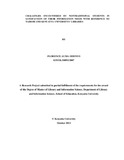| dc.description.abstract | Growing appeal for nontraditional mode of learning in the public universities of Kenya has
placed academic libraries at the centre of attention. This is owed to the crucial role libraries
play in supporting teaching, learning and research activities in the parent universities.
Establishing strong empirical evidence is a necessary foundation stone for libraries to
effectively meet this academic obligation. To this end, this study examined the challenges
nontraditional university students face towards satisfying their information needs from their
respective public university libraries. The study specifically assessed the nature of
information needs of these students, the resource base and services capacity of libraries to
satisfy their information needs and responsiveness of the libraries policy environment to
satisfy these needs.
The study focused on the University of Nairobi and Kenyatta University. The choice of these
universities for the study was informed by their dominance of the student population and
experience in information services provision to students in the university landscape. The
study adopted a combination of quantitative and qualitative research design, and its
theoretical underpinning was the servqual theory of service quality, advanced by
Parasuraman et al. (1988). The data required was obtained from 326 nontraditional students
and 10 library staff with the aid of self-administered open ended questionnaires. In-depth
interviews were also done with the respective university librarians.
The quantitative responses were analyzed with the aid of SPSS computer software and results
summarized under frequency distribution tables and graphs. Analysis of the qualitative
responses was grounded on thematic contents in which the emerging semantic and structural
similarities were grouped together to create response typologies as posited by Glaser and
Strauss (1967), and resultant summaries synchronized with the interpretations of quantitative
attributes.
On the whole, the analysis indicated that while commendable steps in the direction of
meeting user information requirements are notable on the part of libraries, namely extension
of opening hours, automation of resources and expansion of access to online reading
materials, nontraditional students still have diverse information needs. In their effort to
satisfy these needs they are confronted by myriad challenges, ranging from inadequate and
inappropriate information resources of respective libraries to unfavourable policy
frameworks for the library systems. In particular, the results show that lack of time,
inadequate user information literacy especially about online sources and resources,
unfriendly staff establishments and non conducive library opening hours are the major
constraints facing nontraditional students towards satisfaction of their information needs.
On the library services and resources front, the findings indicated that libraries have
inadequate number of staff, equipment and facilities in relation to the large population size
and diverse information needs of nontraditional students. This situation is aggravated by
insufficient financial resources for library operations. In addition, the policy environment
within which libraries function toward satisfaction of information needs of nontraditional
students is peripheral; largely embedded in the regular mode of learning.
These findings have led to the conclusion that nontraditional university students are exposed
to several fundamental challenges relating to satisfaction of their information needs. These
challenges border on their own circumstances, reluctance of the libraries to re-structure their
resources and service and near-rigid library policy frameworks. Ultimately, it is
recommended that measures toward reducing these should take the direction of developing
policies and programmes whose strategies put emphasis on building intense information
literacy of nontraditional students and intense interactive working relations among students,
faculties, libraries management, university administrations and the government. Proposals
for further research in this field and commensurate actions for staff and nontraditional
students are also provided. | en_US |

